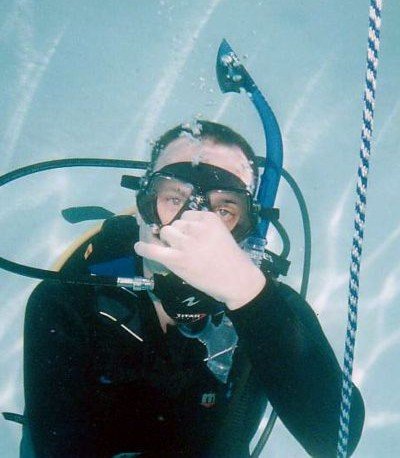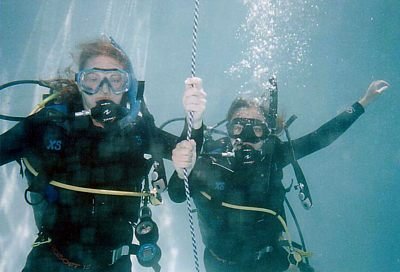Ascents & Descents
Descent Precautions
As you descend, air spaces in your body and equipment will compress. To avoid injury, follow these precautions during your descent.
Equalize your ears early and often. This is easiest if you maintain a feet-first position during the descent. If you cannot equalize, ascend a few feet and try again. Abort the dive if you still cannot equalize.
The air inside your mask must also be equalized. You can equalize your mask by simply exhaling a small amount of air through your nose. You'll learn more about ear and mask squeezes later in this course.
Compression of your wetsuit will make you less buoyant and increase your descent rate. Compensate for this loss of buoyancy by adding small amounts of air to your BCD as you descend. If your buoyancy is properly maintained you should descend no faster than 75 feet per minute, and you will be able to stop at any time by taking a deeper breath.

Descent Procedures
To begin your descent:
- Set your timing device or watch to begin timing the dive.
- Place the 2nd stage in your mouth and signal to your buddy that you are ready to descend.
- Hold the power inflator high above your head and press the deflate button. When the BCD is completely empty, you should slowly descend when you exhale.
- If you are descending along a descent or anchor line, hold onto the line until you reach the bottom. This will help you stay with your buddy and control your descent rate.
- Remember to equalize your ears and mask early and often.
- Compression of your wetsuit may cause your weight belt to become loose. To prevent it from slipping off, tighten the belt if it becomes loose.
Ascent Precautions
Your ascent to the surface is even more critical than your descent. Air spaces expand during ascent, and this can cause overexpansion injuries or decompression sickness if you do not follow safe ascent procedures.
To keep risks of injury to a minimum, ascend no faster than 30 feet per minute. This requires maintaining neutral buoyancy by releasing small amounts of air from your BCD as you swim towards the surface. Never inflate the BCD to lift you to the surface, as this can cause a rapid ascent and serious injury.
Stop your ascent for 3 to 5 minutes when you reach a depth of 15 feet. This is called a safety stop, and allows precautionary decompression before you continue to the surface.
More about decompression sickness and safety stops will be covered later in this site.

Ascent Procedures
To begin your ascent:
- Signal to your buddy that you are ready to ascend.
- Hold the power inflator above your head with your left hand, and the depth gauge in your right hand.
- Establish neutral buoyancy.
- Use your fins to swim towards the surface. Keep an eye on your depth gauge to ensure you ascend no faster than 30 feet per minute.
- Periodically release small amounts of air from your BCD to maintain neutral buoyancy.
- Stop at 15 feet for a 3-5 minute safety stop.
- Continue to the surface. Look up at the surface to ensure there are no boats or platforms overhead.
- Inflate the BCD to establish positive buoyancy when you reach the surface.
- Display the OK signal, and make note of your dive time.